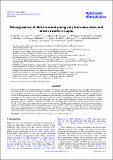Demographics of disks around young very low-mass stars and brown dwarfs in Lupus
Abstract
We present new 890 μm continuum ALMA observations of five brown dwarfs (BDs) with infrared excess in Lupus I and III, which in combination with four previously observed BDs allowed us to study the millimeter properties of the full known BD disk population of onestar-forming region. Emission is detected in five out of the nine BD disks. Dust disk mass, brightness profiles, and characteristic sizes ofthe BD population are inferred from continuum flux and modeling of the observations. Only one source is marginally resolved, allowing for the determination of its disk characteristic size. We conduct a demographic comparison between the properties of disks around BDs and stars in Lupus. Due to the small sample size, we cannot confirm or disprove a drop in the disk mass over stellar mass ratio for BDs, as suggested for Ophiuchus. Nevertheless, we find that all detected BD disks have an estimated dust mass between 0.2 and 3.2 M⊙; these results suggest that the measured solid masses in BD disks cannot explain the observed exoplanet population, analogous to earlier findings on disks around more massive stars. Combined with the low estimated accretion rates, and assuming that the mm-continuum emission is a reliable proxy for the total disk mass, we derive ratios of Ṁacc/Mdisk that are significantly lower than in disks around more massive stars. If confirmed with more accurate measurements of disk gas masses, this result could imply a qualitatively different relationship between disk masses and inward gas transport in BD disks.
Citation
Sanchis , E , Testi , L , Natta , A , Manara , C F , Ercolano , B , Preibisch , T , Henning , T , Facchini , S , Miotello , A , de Gregorio-Monsalvo , I , Lopez , C , Mužić , K , Pascucci , I , Santamaría-Miranda , A , Scholz , A , Tazzari , M , van Terwisga , S & Williams , J P 2020 , ' Demographics of disks around young very low-mass stars and brown dwarfs in Lupus ' , Astronomy & Astrophysics , vol. 633 , A114 . https://doi.org/10.1051/0004-6361/201936913
Publication
Astronomy & Astrophysics
Status
Peer reviewed
ISSN
0004-6361Type
Journal article
Description
Funding: This work was partly supported by the Italian Ministero dell Istruzione, Università e Ricerca through the grant Progetti Premiali 2012 – iALMA (CUP C52I13000140001), by the Deutsche Forschungsgemeinschaft (DFG, German Research Foundation) - Ref no. FOR2634/1TE1024/1-1, and by the DFG cluster of excellence Origins (www.origins-cluster.de), and by the European Union’s Horizon 2020 research and innovation program under the Marie Sklodowska-Curie grant agreement No 823823 (RISE DUSTBUSTERS project). T.H. acknowledges support from the European Research Council under the Horizon 2020 Framework Program via the ERC Advanced Grant Origins 83 24 28. KM acknowledges funding by the Science and Technology Foundation of Portugal (FCT), grants No. IF/00194/2015 and PTDC/FISAST/28731/2017. CM, SF, AM acknowledge an ESO Fellowship. M.T. has been supported by the UK Science and Technology research Council (STFC).Collections
Items in the St Andrews Research Repository are protected by copyright, with all rights reserved, unless otherwise indicated.

